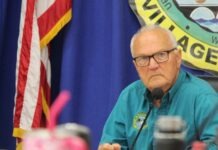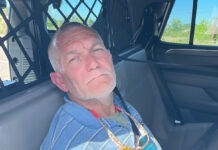Guardrails with vegetation and paved parking with meters are among the items Islamorada council members want staff to pursue for implementation on the Fills at MM 77.6 to MM 79.6.
Village officials will also investigate the Indian Key boat launch’s possible development.
“I want to move forward. We should move forward. The audience wants to move forward,” said Mayor Pete Bacheler following an array of public comments and council discussion on an approach to manage the Fills during a Feb. 17 meeting.
Discussions over the three small islands that connect Upper and Lower Matecumbe Keys go back decades. Property comprising the Fills is owned by the Florida Department of Transportation, with exception to a single parcel on Indian Key Fill that’s leased by the state Department of Environmental Protection’s Division of Recreation and Parks.
Through the years, visitors to Tea Table, Indian and Lignumvitae Keys grew. Issues came to a breaking point following a busy Memorial Day Weekend in 2019, when residents witnessed overflowing dumpsters and all sorts of trash along the nearshore and mangroves.
Not long after that, the village agreed to manage the area that’s owned by FDOT and FDEP. With subleases secured from the state, Islamorada assumed control of the area. From there, village staff created parking spaces, limited area access by vehicles through barricades and cones. They installed trash drums and placed portable toilets.
Village staff were also assigned to monitor visitor activity. The Monroe County Sheriff’s Office worked to reduce the speed limit to 45 mph.
Local citizens concerned about the activity on the Fills say current management activities are working well to quell the uncontrolled activity once seen on the small areas off the road. Many want to keep it that way, as evidenced by opposition to vision plans produced by the village’s consultant, CPH, Inc.
Village council members approved the firm’s hiring in March 2021 for a cost not to exceed $55,000 to create the master plan and do the engineering work. Following one-on-one stakeholder meetings and a survey that garnered 340 responses late last year, two visions came back showing passive and active uses for the Fills. Ideas for trolley service and kayak and boat access were shown in vision plans, as well as restroom facilities and pavilions.
CPH consultants were set to appear to discuss results with the council on Feb. 17, but no presentation was given due to opposition against the ideas.
Acting Village Manager Maria Bassett said the gathering of ideas for certain amenities and uses residents wanted to see, or not see, was the whole intent behind the visioning process for the Fills.
“Under the two leases, there’s no requirement we do anything,” she said. “We asked for leases to decide what improvements we’d like to see. Under leases, if there are improvements we want to make, we gotta submit a plan.”
Councilman David Webb said the survey results and process did not bring an actionable result. Webb examined written comments given by some 190 people who responded to the survey. Of the comments, Webb acknowledged that no one said anything about wanting overlooks, piers or pavilions. His analysis also found that 87% of people support either minimal or moderate use on the Fills.
Webb went on to say that Florida is consistent when it comes to providing residents and tourists with access to public property. Per language within the Fills sublease, the village can enact measures that it deems reasonably necessary for public safety purposes, but it cannot take or permit any actions that limit public access in a discriminatory manner or that limit public access for any reason other than public safety.
While the council could walk away from leases and forgo management activities, Webb said the village could witness what happened before they took over the Fills. Phyllis Mitchell, former member of the Friends of the Islamorada Area State Parks, said the group would use long-handled picks to grab what she called “nastiness” during cleanups throughout the year. Mitchell said the group cleaned the area of MM 78 to MM 79 on the Fill as part of the adopt-a-highway program.
“We collected 50 or 60 large bags each time we cleaned,” she said. “As chairman of the group, I’ve learned a few things about the people who regularly used the Fill. They did not care to pick up after themselves, they did not care to take their trash home, and they did not care to throw their trash in the dumpster, even if it was 10 feet away.”
Mitchell urged the dais to maintain passive uses at the Fills while only maintaining a few parking areas.
Lisa Bosch created a petition that urged on the side of no development on the Fills. As of Feb. 17, 414 signatures were secured.
“Taxpayers do not wanna pay for park amenities for day trippers,” she said. “I feel completely ripped off by CPH. I think the data was flawed for sure.”
A stakeholder survey presentation by CPH Inc. gathered some 344 responses from local residents. Of those responding, 92% said they owned property in the village. In total, 184 residents, or 53% of respondents, strongly disagreed with the idea of bringing active recreation, like boat and kayak access, to Indian Key Fill. Sixty residents said they strongly agreed with the idea.
As for parking, 212 of respondents, or 61%, strongly disagreed with the idea on the Fills. But if parking was provided, 267 residents, or 77% or respondents, said they believed people should be charged for using the parking spots. A majority also believed in charges for boat launch parking.
A total of 126 residents, or 36% of responses, said there should be pedestrian-only access areas for quick photo opportunities.
Capt. Ed Davidson said the data provided by CPH was fundamentally flawed and skewed by a bias consultant. He said it was an advocacy campaign that forced residents to repeatedly choose the “lesser of two evils.” He also acknowledged that amenities presented in the Fills visions didn’t outline costs.
“This was not an impartial, neutral survey. It was a biased, forced choice,” he said. “Before listening to any more flawed, advocacy contrived presentations from a consultant, a valid survey should be mailed to every one of the 5,429 registered voters. If you send them a survey with an estimated cost, you will get a vastly larger and more adamant response.”
Davidson added that the three small islands that make up the Fills are “simply shoulders of road to somewhere else.”
Bill Doxey, president of the Florida Keys Scenic Corridor Alliance, said board members were in favor of improvements to the water access for kayaks and paddleboards, controlled paid parking, picnic tables, toilet facilities and providing a sufficient number of garbage cans.
“The Fills is a scenic view and gateway to three state parks, Indian Key, Lignumvitae Key and San Pedro,” he said. “To deny access to them via closure is unbefitting to the Keys. U.S. 1 isn’t owned by Islamorada or Monroe County. It’s a state road, and therefore it’s accessible to all those who choose to visit our beautiful islands. The same should be for the Fills and nearby state parks.”
Councilman Buddy Pinder said the current council inherited the Fills problem. He said FDOT wanted to install a guardrail along the Fills for $4.9 million with the previous council.
“Nobody in the village was going to have to pay for it. They were going to pay for it,” he said. “We didn’t. This council inherited this.”
Councilman Mark Gregg expressed the idea of getting rid of the Fills and building an elevated bridge so the water can naturally flow underneath.
“I’ve had this conversation with state Rep. Jim Mooney a year or two ago, and there is some interest in that. It’s just very expensive and it takes a long time to plan that.”
Following public comment and council discussion, Councilman Henry Rosenthal proposed the village inform FDOT of its desire to immediately remove cones and tape from the entire length of the Fills. He also requested adding more parking signs with a $200 fine, designating existing parking areas with a 30-minute time limit and holding off on opening the boat launch on Indian Key until the village determines what’s best for the taxpayers and environment.
“It’s time to do something,” he said. “We’re not going to deal with this whole thing with the person we hired, but it’s partly our fault even though I criticized this.”
Rosenthal’s motion died with no second from the dais.
Bacheler followed with a motion for staff to come up with a concept with a guardrail and vegetation and paid parking. A unanimous vote of approval ended a discussion that lasted some two hours.
Discussions over barricades at the Fills last occurred at a July 2020 meeting. Public Works Director A.J. Engelmeyer provided three options at that time to council members. They included a cable barrier for an estimated cost of $322,000, timber with rope for approximately $476,000 and guardrails for around $644,000.























